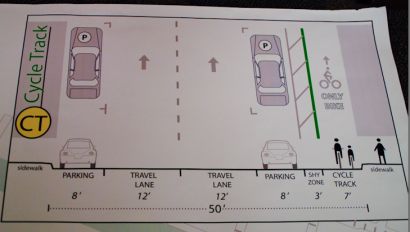
(Photos © J. Maus)
Speaking at a sustainability conference at Portland State University this morning, Portland Mayor Sam Adams announced a big shake-up in his plans to build the city’s first “high-profile” cycletrack.
“It will be shocking to a lot of Portlanders…and we hope it’s shockingly positive.”
— Mayor Adams, speaking about a new cycletrack on SW Broadway
Initial plans revealed last month had the cycletrack (which was one of his “First 100 Days” promises) going in at the North Park Blocks. But those plans are out because the Portland Fire Bureau said there wouldn’t be enough room for their trucks to operate on the street if it was narrowed for the new bikeway.
I spoke to Adams’ transportation policy director Catherine Ciarlo this morning and she said the Fire Bureau issue is “an intractable problem and we can’t work around it.” (In Europe, Ciarlo told me, fire trucks are much smaller).
But the problem seems more like a blessing in disguise. The new cycletrack — which both Ciarlo and Adams says has always been in the plans — will be much more high-profile (the Park Blocks cycletrack had a lot of detractors). Adams announced this morning that the new cycletrack will run on SW Broadway from Clay to SW Jackson — right through the heart of the Portland State University campus.
To complete the cycletrack, the city intends to remove one of the three existing motor vehicle lanes. The new road configuration will include a 7-foot bikeway, a 3-foot “shy zone” (so people can get out of their cars and open doors without impeding bike traffic), an 8-foot parking lane, and then two, 12-feet motor vehicle lanes.
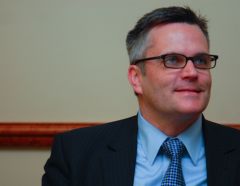
When asked how they’ll deal with potential pushback about removing a motor vehicle lane from a major downtown street, Ciarlo said SW Broadway is “under capacity” in that area (which made the location “even more attractive” to them).
Ciarlo said their office feels that the capacity will actually increase once the cycletrack is installed. “It will change the number of lanes, but it won’t significantly effect the number of vehicles,” she said, “but it will increase the number of bikes…so it’s really a win-win.”
Ciarlo also added that they have done significant outreach to business owners and to PSU officials and that everyone is “excited” about the project.
In addition to this new cycletrack, PBOT also has new plans to install a “buffered bike lane”. The location of the new buffered bike lane — which will be installed in conjunction with this new cycletrack — is expected to be announced publicly next week.
The SW Broadway cycletrack is expected to be installed this summer and it will drastically alter the streetscape. Speaking with me before addressing the PSU sustainability conference this morning, Adams said he thinks the project “will be shocking to a lot of Portlanders…and we hope it’s shockingly positive.”
According to Adams, a high profile bikeway in this location will serve an “untapped capacity” which makes it a “great test case”.
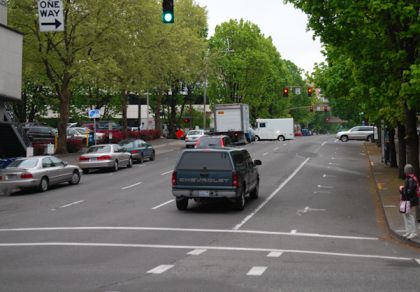
Ciarlo, Adams’ transportation policy director, said the new facility will provide benefits not just for people who bike, but that it “will also provide a huge humanizing benefit for PSU students and pedestrians. The cycletrack will give the entire area a very different feel.”
- Cycletrack: Exclusive bicycle facility
adjacent to — but separated from —
the roadway by a physical barrier
(which in this case will be parked cars.)
- Buffered bike lane: Roadway
designated by buffered striping
and bicycle pavement markings
for the exclusive or preferential
use of bicycles.
Asked how the new facility will be paid for, Adams said, “We will identify a funding source in my proposed budget.” That statement would lead me to believe that Adams’ budget — which is set to be unveiled Friday evening — might include some sort of new, dedicated funding stream specifically for bike projects.
I don’t have specific budget estimates for this project (will have them soon), but Rob Burchfield, head traffic engineer for PBOT, said it will have only a “modest” cost. Like the bike boxes, this new roadway treatment will only consist of paint and signs and will therefore not be a very expensive. Burchfield estimates it will cost $47,000 (not counting outreach and marketing).
Also new this morning is an announcement that PBOT will work with the Institute for Bicycle and Pedestrian Innovation at PSU to conduct an evaluation study that compares the functionality and impact of the cycletrack versus the buffered bike lane.
Stay tuned for further developments.
You can learn all about PBOT’s plans for cycletracks, buffered bike lanes, and much more at the upcoming Bicycle and Streetcar Master Plan Update Open Houses. Check out when and where they’re happening in your neighborhood.





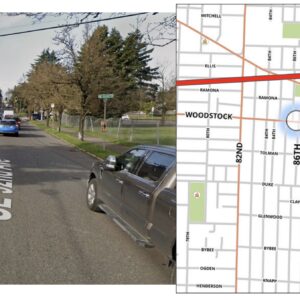
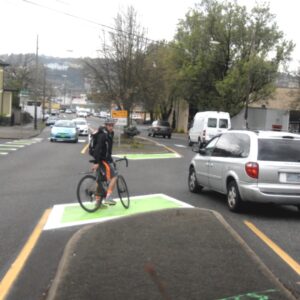
Thanks for reading.
BikePortland has served this community with independent community journalism since 2005. We rely on subscriptions from readers like you to survive. Your financial support is vital in keeping this valuable resource alive and well.
Please subscribe today to strengthen and expand our work.
fantastic!
now if we can just get it extended the full length of Broadway and avoid all of those nasty conflicts near the hotels…
Why is 7 blocks of track such a big deal?
because it’s seven times what we have now and it is in a high profile location. …at least that’s MY opinion.
Nice. I concur about the hotels, but still, nice.
mike,
i think this is a very big deal because they’re taking away an existing motor vehicle lane.
also, if it works, it could be a very highly-trafficked bikeway which would then put a lot of other gears in motion…
it’s also another important step toward phasing cars out of downtown.
also, next week they’ll announce the location of the buffered bike lane… which is again, a re-allocation of roadway space away from cars and towards bikes…. a very good thing.
I think its a big deal because it’s a first step, and will get people used to the idea of a cycle track. It has to start somewhere, and I think that this is a good, high profile start. I like this decision even though my neighborhood looses the N Park Blocks cycle path.
Re #5:
I hope it does turn into more. Baby steps, I guess.
Do you think a car-free downtown Portland will happen in your lifetime?
A fine idea and indeed a big deal. Very encouraging. (Also, I can’t wait to hear and read what the Cantankerous Front will have to say. I’m referring to the righteous anti-cycle crowd, the folks who usually write in at The O.)
without a doubt. absolutely. the writing is on the wall.
Removing a main travel lane on Broadway? That gives pause for consideration. If, as editor Maus reports, ‘Ciarlo said SW Broadway is “under capacity” ‘, I wonder if they’ve determined this to be true during rush hour. That section of Broadway can be very congested at times because people are jockeying around trying to get on-street parking while others are trying to make their way through further south to exit onto I-405.
This seems like an excellent idea from the University’s perspective, but I’m really wondering how it’s going to work out for traffic in general. It seems like an idea worth experimenting with at any rate.
I’m excited to see this and get the experiment underway to see how well cycletracks can work here. The concept has been somewhat controversial, and I’m eager to ride one to see for myself.
So stupid. Sounds like a project that will serve no other purpose beyond self-congratulation for the city government and getting write-ups in magazines. It won’t benefit cyclists like myself, and it’s a complete waste of money at a time where the city is deep in debt.
Oh well, I guess the bright side is that they are no longer planning to destroy Park and 9th — which are already perfectly good biking streets — with this ridiculous scheme. Downtown traffic is slow enough for cyclists to integrate with it — we don’t need the padded cell treatment.
You might see a car-free downtown if energy prices become permanently high, making driving unaffordable for most people (and under those circumstances, cyclists wouldn’t need any specialized infrastructure). Until then, however, banning cars downtown would only increase “job sprawl” to the suburbs. People are going to drive until they can’t, and they are going to prefer places that allow them to.
Downtown Portland isn’t special or important enough to get away with that sort of thing — it isn’t the international business meccas that Manhattan or central London are.
I ride through Old Town up to PSU along SW Broadway most days of the week.
I’m glad we’re demonstrating a traffic redesign, as was earlier done with the bike boxes that were added, but these engineering gizmos haven’t made the most dangerous part of SW Broadway safer.
The problem area on SW Broadway is the hotel district from the Benson to the Heathman, where cabs, shuttle buses and rental cars dodge in and out, park and get met by valets to tug around the guests and their luggage through a high traffic bike lane.
The only reason more cyclists don’t get hit is because we spend a lot of our energy dodging the cars and their passengers.
Why not move their loading zone to the side street? Why not segment the traffic around them? Why not a failure to yield to bicycles sting? Why a cycletrack in an “under-capacity” area?
This stretch of Broadway is part of my daily commute to OHSU. It will be interesting to see how it will affect my commute. At times there are plenty of pedestrians near PSU and they tend to cross against the light. Usually I’m concerned with doors on my right but now I will have doors/passengers on my left and also the pedestrians on my right.
HOTELS
Extending it past the hotels in the future will be a nice problem to have. I’ve ridden the area a few times, though not during commuting hours, and the hotel area doesn’t seem that congested, but the valet/loading zones would be an awkward street space to work around.
TRAFFIC MALL
It is interesting that this is a block West of the redesigned traffic mall on 6th. Its one way running South, opposite direction of the traffic mall, so unfortunately it is not an alternative to 6th for bikes. Long term, what would be the best North/South pair to make a significant bike corridor?
How do we keep the pedestrians from using the cycletrack like another sidewalk?
It seems like a bad idea to have the bike lane inside the parking area. How do bikes turn left? How do cars turn right? What happens when there’s an obstacle in the cycle-track?
What is the “physical barrier”? Is it big enough to keep motorists from using the cycle-track as a pick-up/drop-off zone?
Alas, our mayor and city government care more about its “green” image than the actual logistics of riding a bike.
Let’s just stick with the bike boulevard thing, as we already know that it actually works. The built environment of Holland is very different than here, and cyclists have always constituted a large modal share. I don’t think people can rightfully assume that their methods would work here.
chrisnw,
bike boulevards are for residential areas. we’re talking about the city here.
also, do you have a different idea for creating more bike-friendly space on downtown streets? (and yes, I realize people can just ride with traffic, but that’s not feasible for a lot of people).
many city’s in Europe have adopted the attitude of no longer making it not so attractive to drive a car around downtown and instead focusing on mass transit,cycling & truck delivery efficiency.
It’s simple..if you cannot monitor the resource yourself, we will not accommodate your wastefulness.
I’m disappointed that this will not include the section of Broadway where Kristine was killed in 2005.
The hotel loading zones are the worst part of SW Broadway. I’m disappointed this doesn’t address that area, but perhaps it’ll encourage us to address it in the near future.
“without a doubt. absolutely. the writing is on the wall.”
Do you honestly think the entirety of downtown will be car free? What planet do you live on? Maybe a few streets, but all of downtown. Never.
It’s a relatively small stretch, but I agree that in this case the symbolism is important – to prove what can be done. And the PSU connection is perfect, considering the bike-centric work that’s happening there in the department of Urban Studies and Planning. This will create a kind of real-world display window for them.
GLV,
not 100% carfree…but you never know.
there will be some delivery cars/trucks and still some holdouts getting to work, but yes, I do believe we’ll see a massive shift in downtown mode share.
when there is no good reason to drive downtown, people will stop driving downtown.
never say never GLV!
and I live on earth, just to answer your question.
the drawing does not show a grade separation or a curb, so I am guessing the physical barrier is bollards, though burchfield says just paint and signage. not sure how paint and signage “dramatically alter[s] the streetscape.” it will be interesting to see what they propose for managing conflict points at the intersections. and assuming there is a public hearing to designate the facility as “suitable,” 814.420 will make this a mandatory sidepath. agree it is good the park blocks are off the table, but this is not necessarily an improvement.
If Scam Adams thinks this is going to get the cycling “community” behind him he’s sorely mistaken. I could care less about 7 blocks near PSU.
This is cool. I’ll go out of my way to ride on it once it’s done. Don’t let perfect be the enemy of the good. Simple eh?
“also, do you have a different idea for creating more bike-friendly space on downtown streets? (and yes, I realize people can just ride with traffic, but that’s not feasible for a lot of people).”
Yeah, eliminating all those pesky surface streetcar and MAX tracks would be a good start, but I’m not going to hold my breath on that one.
As for people who find slow 15 mph downtown traffic intimidating, my suggestion is: don’t ride. Biking is not for everybody. I don’t share your philosophy that current and actual riders should be punished for the sake catering to *potential* and not yet existing riders, who may or may not start to ride after these infrastructural measures are implemented. Most people I know do not ride bikes on a regular basis, and are not going to ride a bike no matter how easy you make it for them. You can only make cycling so easy and safe up to a point before you start to get diminishing returns. Davis and Irvine, CA have a very thorough network of separated MUPs. While Davis’ ridership is decent, it’s modal share is only 15%, just barely higher than ours.
What’s with the evangelism anyway? Riding a bike works for some, but not for others. Me, I just like to ride. It’s not my aim to convert people, as I know that many peoples’ needs are better served by other modes of transport.
If we were letting perfect be the enemy of good, you might have a point.
Instead we are letting stupid and wasteful be the enemy of good. Simple, eh?
RE: my “evangelism”.
I get excited sometimes. that’s all. i’m not trying to force anybody to do anything, I just see amazing potential for Portland.
RE: physical separation.
i should have been more clear in the story… but the way PBOT is planning their cycletracks, the separation would only come from parked cars.
this is a desperately stupid move by Sam to win the support of a few noisy and selfish dutch-o-phile cyclists.
Are they going to install a separate bike signal phase? Are they going to prohibit motorists from making right turns off of Broadway? Will cyclists still be able to ride in the regular lanes after the cycle track is built? If the answer to all of these questions is no, this project should not move forward.
Cycle tracks are just a new name for thoroughly discredited side paths.
Perfectly said, Burr.
This is sure to rally up the bike advocacy droids, nothing more.
“without a doubt. absolutely. the writing is on the wall.”
Jonathon, are you considering (or have you in the past written) writing an editorial post on the subject of a carfree downtown Portland? I’d love to hear more about your certainty and the steps that need to be taken to get there.
I live downtown and this idea crosses my mind fairly often. I have to say that I agree with you that it’s only a matter of time. It seems like downtown Portland has the perfect constrained geography to pull this off.
“…it’s also another important step toward phasing cars out of downtown.”
Really? Isn’t that goal just a little over the top? I enjoy your enthusiasm for cycling, but maybe just a wee-bit overstated. Don’t want to “feed the bears” on The Oregonian’s rant page.
looking closer, I see that they picked a location where there are no right turns possible across the cycle track, due to the presence of the PSU campus.
I guess this way they can say it was a success even though the biggest hazard to cyclists isn’t present along the entire length of this project.
the separation would only come from parked cars
That’s a drag. The cycle track will turn into a car loading zone, and to avoid cars there, you’ll have to get outside the parking zone and then back in later.
I’m still curious about the turning arrangements (left for bikes/right for cars).
BTW, I’m not a vehicular dude that opposes all bike infrastructure. I’m just skeptical about cars parked to the left of a travel lane.
Hmmm, I’m torn, part of me agrees with #28:
“If Scam Adams thinks this is going to get the cycling “community” behind him he’s sorely mistaken.”
But I also agree with #3: “because it’s seven times what we have now and it is in a high profile location”.
The deatils are a bit fuzzy to me also, like how new paint is going to make such a big deal, seems like the impact would be more pronounced if there was going to be a physical barrier. But beggars can’t be choosers I guess, and it probably will be a good step forward.
@ #33 BURR and #34 STEVE
ouch… why the hate?
Steve, what is your argument on the stupidity and wastefulness of this?
@ #30 chriswnw
don’t worry, no one is forcing you to convince others to ride their bikes. You are completely free to continue exhibiting the selfish attitude displayed in your comments above and advocate for eliminating all rail based transportation downtown or any other impediments to your desire for vehicular cycling.
Okay wtf? How are bikes supposed to turn left with parked cars in the way? How are cars supposed to turn right without hitting bikes, as the blocked cars would block their line of sight? I, for one, will boycott this lane and continue to ride in traffic. It’s ridiculous – I’m not going in a straight line from Clay to Jackson.
This is a cool idea but it’s really going to suck. We’re going to be expected to use the lane. People that might be traveling two blocks on Broadway will be forced to waste time merging into this little lane and finding a way to get out of it and cross the street.
I don’t know. Maybe it works for most people out there but people that enjoy going a decent speed on bikes (most young commuters) are not going to use this.
@ #40. Because these clowns are building something most smart cyclists would not use willingly but will be forced to use or face citations under ORS 814.420.
Scott-
The arguments against American style cycle tracks have been repeated ad nauseam, both on this site and in many other locales. If you can’t be bothered to educate yourself as to the nuances of complex issues, I am not going to pick up the slack.
So sorry!
Check it out: http://www.bikeforums.net/showthread.php?t=536636
chriswnw (#19) – Cycle Tracks work great in Europe, but they’re still very new here. Even in the cities currently experimenting with them, the results may not be completely valid here because PacNW people have their own driving patterns which are very different from places like NYC. The only way to see if it’s a valid solution to the problem is to build one and see what happens.
It’s inexpensive, easy to revert, and something that will instantly reinforce to motorists that they can’t just relax and operate the car on autopilot – it’s new, and different, which grabs a driver’s attention and puts it back on the road where it belongs.
We live in an imperfect world, in challenging economic times and an evolving energy environment. While the fossil fuel-powered auto is about to enter terminal decline, there’s still the chance that an alternate fuel might keep things going – and in any case, the evolution to a new system of transportation may take decades to realize. (Indeed, the current one took 50 years) None of us can afford to be stagnant, unyielding, unchanging – the system has to evolve, and that means experiments need to be made. Some will fail, some will waste money – but the successes don’t happen without the failures. If we could predict success with any real accuracy, none of us would need to work and we wouldn’t all be complaining about government and how we perceive it to NOT be meeting our needs.
This is a great idea, a great implementation, and a very visible location. And if it fails, it’ll be public enough to discourage another one. If it succeeds, then why should any of us complain? The issue isn’t how we get there, it’s giving cyclists the same level of access and safety that motorists enjoy (and vice versa).
and in response to (#30) – First, how does this punish current riders? Second, 15% is 2-3x what Portland currently has (probably 2x), which is a lot more than “just barely”, and third, “What’s with the evangelism?” – in my case, it’s because we can’t all continue to drive cars – some of us HAVE to transition to other, smaller modes. There is a fixed amount of space and not everyone can drive in it. The more people we have moving here, the more that fact is true. For the extreme example, look at Manhattan, where only a very small fraction of the population drives.
We have a choice between encouraging alternate modes now, or mandating them later – either through government regulation or market-based pricing. I’d rather have people leave their cars voluntarily rather than being forced to, and I think most people given that choice would agree.
Cars turning right isn’t an issue here, because they aren’t able to drive through the middle of the PSU campus. The roads don’t go through.
i believe that any new infrastructure that de-legitimizes (in the public/driver eye) a cyclist right to travel on a public road is ultimately damaging.
i am a proponent of vehicular cycling (which i understand is not a choice for everyone), and i believe that we need as many bike in the streets (lanes of traffic) so that car/trucks/etc. will take it as a given (and not the exception) that there will be bikes on the road.
@ #43 Steve
Thanks. I appreciate your generosity.
Well put, Matt Picio!
Matt, from the Wikipedia article on Davis where I got that figure: “From 1990 to 2000, the U.S. census reported a decline in the fraction of commuters traveling by bicycle, from 22 percent to 15 percent.”
15 percent is down from what it previously was. My point is that ridership will only rise so high unless alternatives that people find preferable are no longer an option for them. Driving is easier and cheaper in Davis than in Amsterdam.